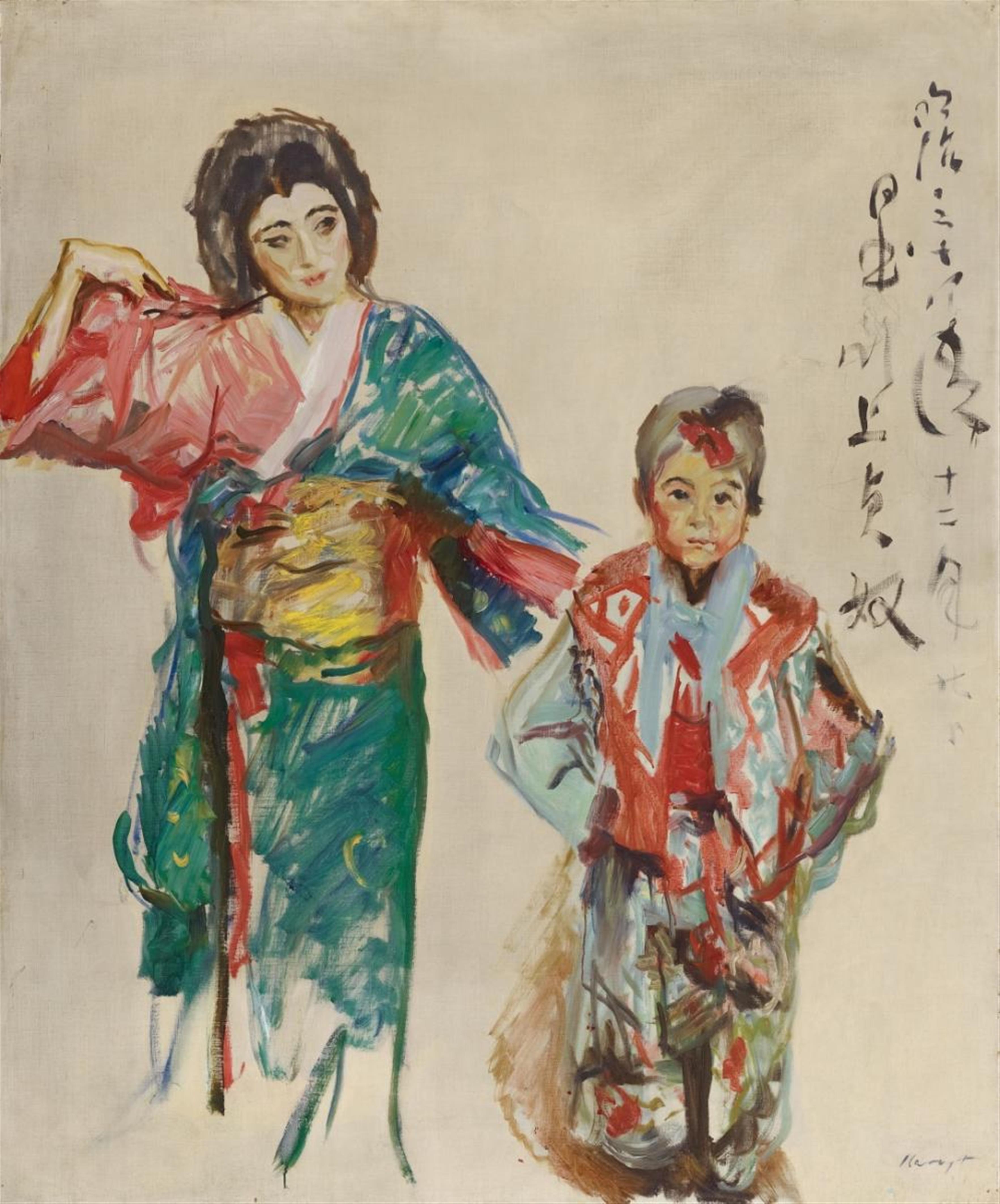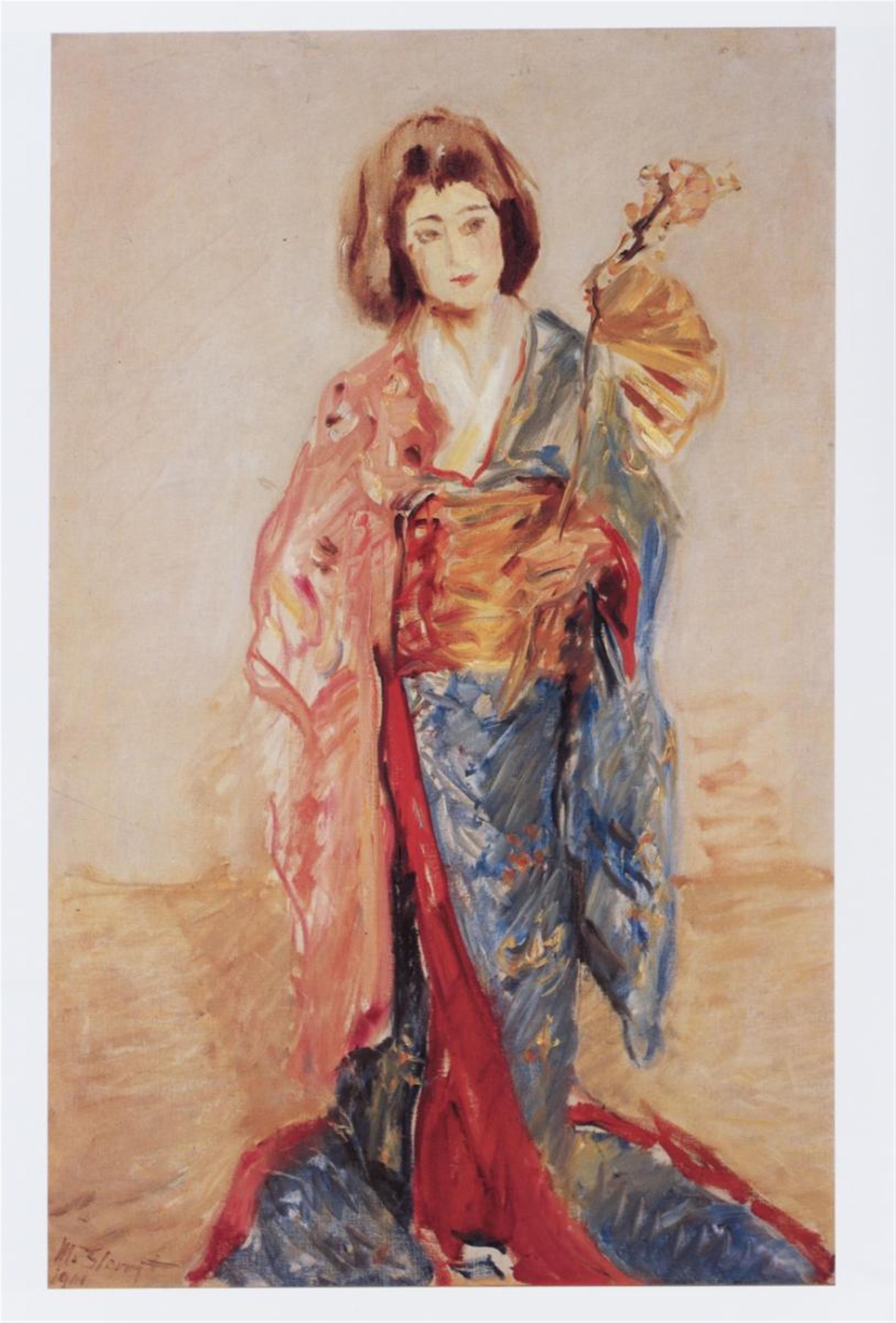Oil on canvas 132.2 x 110.5 cm, framed. Signed 'Slevogt' in blue lower right. In upper right margin additionally inscribed and dated in two lines in Japanese by Sadayakko with black brush: "Meiji 34 nen 12 gatsu muika/ Nihon Kawakami Sadayakko" resp. translated: "Meiji 34 [= 1901], 12th month, 20th day/ Kawakami Sadayakko from Japan". - Within the left Japanese brush script a thin, barely discernible pencil sketch of the dancer in profile as a walking draped figure. - At few places with small professional retouchings.
Imiela, annotation 15, 2., p. 373
Rau Collection for UNICEF
Around 1900 it was Sadayakko (or "Sada Yacco", 1868-1932) and her husband Kawakami Otojiro's celebrated theatre company who introduced Japanese theatre to the Western world for the first time. It had been virtually unknown in Europe until then. People were absolutely fascinated by the aesthetic beauty of those amazingly colourful performances. A tour of the United States and France turned out to be quite sensational. Graceful Sadayakko had been dancing at the World Exposition in Paris in 1900, then giving guest performances in Berlin in November and December 1901. She was perceived as a highly unusual and enchanting actress - in both Berlin theatres, in the "Zentral-Theater" and in "Buntes Theater" (also known as "Überbrettl"), newly established by Ernst von Wolzogen. German newspaper articles even compared her stage acting to a work of fine art:
"We are faced with a tableau coming alive and beginning to move, continuously changing into the shapes of thousand new images, each one as perfect as the other." ("Der Tag", Berlin, quoted in Peter Pantzer, op. cit., p. LXIV).
Sadayakko's performances are well documented, and so are the two paintings of "Sada Yacco" by Max Slevogt who himself took the note, that he created them in "the winter of 01/ to 2" (Bernhard Geil, Slevogt Archives). Former, traditionally assumed dates of Sadayakk's portraits ("1906") can be regarded as erroneous.
This painting is one of Slevogt's first masterpieces in Berlin after his move from Munich in November 1901. It is distinguished from the stage portrait of the Kohl-Weigand Collection (now: Saarland Museum, Saarbrücken, see comparative illus.), which is roughly about equal in size, by rendering Sadayakko's delicate movements. Unlike the other portrait, this painting has been further enriched, both formally and in it's narrative, by the presence of the child. Another major compositional element are the calligraphic brushstrokes, written by the Japanese dancer herself: they have been preserved like some precious foreign autograph, inscribed into Slevogt's picture as a graphic feature and on the same level as the pictorial composition itself. The painter even seems to have responded to it artistically by adding a dark vertical brushstroke to the dancer's brightly colourful kimono, balancing out imperceptibly the two sides of the painting's large format.
The characteristics and the specific qualities of Slevogt's art had found an ideal counterpart in this Japanese theme: the negation of space and the blank backdrop, the non-corporeal character of the figure and the impulsive sketchiness of the depicted subject, the intensive colours and the abstract interplay of lines and brushstrokes - all these elements are aesthetic aspects of East Asian art. Nevertheless, they are fundamental features of Slevogt's own art, his "line" has positivly been described as an "element of meaning", touching the distinct idea of his approach to painting (Meinrad Maria Grewenig, Max Slevogts impressionistisches Bildkonzept, in: Max Slevogt, exhib. cat. Saarland Museum Saarbrücken, 1992, p. 133).
As for the subject, there are direct links to other stage studies by Slevogt, painted during the same period as this portrait of Sadayakko - the theme of Mozart's Don Giovanni and Slevogt's realisation of "Das Champagnerlied" (1902, Staatsgalerie Stuttgart). The latter is a portrait of the singer Francisco d'Andrade in his role on stage, painted subsequently after "Sada Yacco".
"Slevogt's art - its 'music' - is 'modern' [...] Despite all impressionist sensitivity for surface textures, it is full of contradictions - contradictions between figure and plane, the whole and its parts, between expressive, energetic lines and the colours that have been either disrupted or liberated in their streaming, and contradictions between the nervousness and tearing flow of time and the hovering quality of the moment." (Lorenz Dittmann, Max Slevogt: Farbe und Zeitgestalt, in: exhib. cat. Saarbrücken, op.cit., p. 125).
Certificate
We would like to thank Peter Pantzer, Vienna (Prof. Dr. em., Institute for Japanology, University of Bonn), for kind assistance and scientific details as well as Bernhard Geil, Slevogthof Neukastel, for further advice. We thank Sigrun Paas, Mainz, for additional information.
Provenance
Gift of the artist to Janos Plesch, Berlin; prof. Peter H. Plesch (J. Plesch's son); Christie's London, 1985 (acquired there)
Literature
Hans-Jürgen Imiela, Das Bildnis des Francisco d'Andrade als Don Giovanni und die Schauspieler-Rollenporträts, in: Max Slevogt, Eine Monographie, Karlsruhe 1968, pp. 69 ff., especially p. 78;Christie, Manson & Woods Ltd., London 3 Dec.1985, Impressionist and Modern paintings and sculpture, Part II, lot 152 with colour illus. p. 64 ("The Property of Professor Peter Plesch/ Max Slevogt, Sada Yakko and a Japanese Child"), here erranously dated ("20 December 1906"); Marc Restellini (ed.), Meisterwerke von Fra Angelico bis Bonnard. Fünf Jahrhunderte Malerei. Die Sammlung des Dr. Rau, exhib. cat. Wallraf-Richartz-Museum in the Josef-Haubrich-Kunsthalle Cologne/ Haus der Kunst, Munich, Geneva 2001, cat. no. 80, p. 198 with colour illus. p. 199 (erroneously dated "1906"); Peter Pantzer, Japanischer Theaterhimmel über Europas Bühnen, Kawakami Otojiro, Sadayakko und ihre Truppe auf Tournee durch Mittel- und Osteuropa 1901/1902, Munich 2005, with colour illus. after p. XI ("Sadayakko with her foster-son Raikichi in Berlin"), pp. LXV, LXXVIII, cf. illus. 2 and 5; Curt-Engelhorn-Stiftung/Reis-Engelhorn-Museen/Verband der Deutsch-Japanischen Gesellschaften (ed.), Ferne Gefährten. 150 Jahre deutsch-japanische Beziehungen, Begleitband zur Sonderausstellung, Regensburg 2011, no. 103 with illus., pp. 138/139
Exhibitions
Travelling exhibition Japan 1999-2000: Tokyo/Miyazaki/Shimane/Yokohama/Ehime (Yasuda Kasai Museum of Art, Tokyo/ Miyazaki Prefectural Art Museum/ Shimane Art Museum,/ Sogo Museum of Art, Yokohama/ The Museum of Art, Ehime), Masterpieces from the Rau Collection: from Fra Angelico to Bonnard, cat. no. 80 with colour illus. ("Portrait of Sada Yakko and a Japanese Child", dated "1906"); travelling exhibition Europe 2000-2002: Paris/ Rotterdam 2000/2001 (Musée du Luxembourg/ Kunsthalle Rotterdam), From Fra Angelico to Bonnard, Masterpieces from the Rau Collection, cat. no. 80 with colour illus. (dated "1906"); Cologne/Munich 2001/2002 (Josef-Haubrich-Kunsthalle/ Haus der Kunst), Meisterwerke von Fra Angelico bis Bonnard. Fünf Jahrhunderte Malerei. Die Sammlung des Dr. Rau, cat. no. 80 with colour illus. (dated "1906"); Bergamo 2002 (Accademia Carrara), Collection Gustav Rau; travelling exhibition South and North America 2002-2006: Bogota 2002 (Casa de la Moneda, Biblioteca Luis Angel Arango), Collection Gustav Rau; Portland/ Dayton/ Nashville 2004/ 2005/ 2006 (Portland Art Museum/ The Dayton Art Institute/ Tennessee State Museum Nashville), Rau Collection; Mannheim 2011/2012 (Curt-Engelhorn-Foundation for the Reiss-Engelhorn-Museums), Ferne Gefährten. 150 Jahre deutsch-japanische Beziehungen, cat. no. 103




